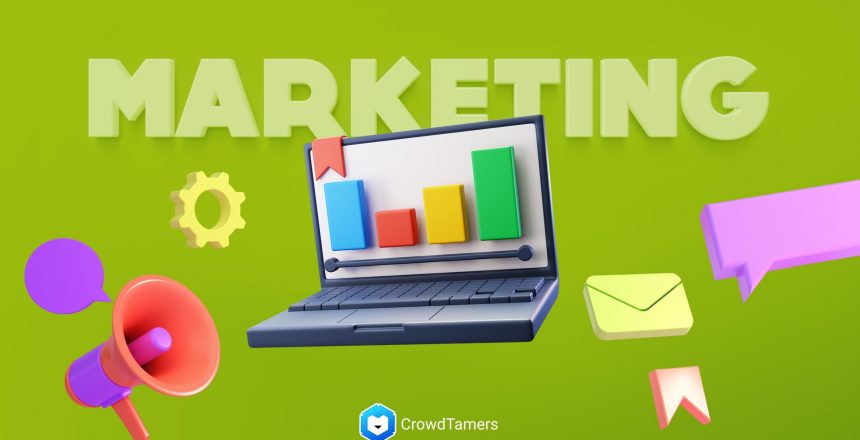Marketing is not a one-person show. Especially when it comes to Growth Marketing, where the goal is to grow your business. To achieve this goal, you need an approach that will help you measure and optimize your acquisition, activation, retention, and referral efforts. This article will explain how to create a growth marketing framework to keep your growth efforts on track.
So, what’s a Growth Marketing Framework?
Growth Marketing Framework is a set of practices and rules that’ll ensure your experiments are clear, measurable, and analyzed correctly. It’s an easy process to identify problems or opportunities to find the right solutions (or ideas) that work best for you. If followed consistently throughout all of your efforts, these frameworks can be successful AND efficient!
In this article, you’ll learn how to create your own marketing framework that works best for your situation.

Now, how to create a growth marketing framework?
1 – Define & measure your marketing funnel
It is very common for companies to be unaware of what their marketing model looks like. They might have a standard version (consideration, awareness, advocacy, conversion), but they have not built one that is right for them. As a result, they do not know what stages their customers go through when interacting with the product, let alone measure what proportion of customers actually go through those stages.
The reason to do this is that it can show you where your weaknesses and opportunities are. For example, by going through the process of defining & measuring your marketing funnel, you may spot that you have an unusually low conversion %age or an unusually low advocacy rate.
There are 2 steps to getting the info you need to do this:
- Quantitative: Use the data collected by your company to analyze the no. of customers passing through each step.
- Qualitative: Talk to your users to see what stages they go through.
By doing this, you will put yourself in a better position to choose the right goals to help your business grow.
2- Define Your Objectives & Key Results (OKRs)
It does seem obvious, but you need to be clear about reaching the goal. Once you have got your funnel fleshed out, you should see a picture of what you need to improve.
Objectives and Key Results are a way of defining your goals that makes ’em measurable, achievable, and practical. OKRs are goals that an individual or a team can be held accountable to. They aren’t just plucked out of thin air; they are based on data & market understanding.
To turn your goal into an OKR, you will add key results that plot the way to the endpoint. For example: reducing churn by X% or raising the average initial order value by Y%. Ideally, you will have around three key results per objective, & these key results should be clear, measurable milestones that’ll help you achieve the objective.
3- Brainstorm ideas
Once you’ve defined your OKRs, bring your team together and think of ideas to hit ’em. There’s not a huge amount to this, but here are some key pointers:
- Everyone needs to be encouraged to contribute. A contribution does not need to be an idea – it could be a relevant question that reveals the shortfalls in someone else’s idea.
- Everyone should be able to separate themselves from their own ideas. Often when someone contributes an idea for a particular project, they see it as an extension of themselves. That can lead to feeling personally attacked if someone criticizes an idea or has failed if their idea doesn’t get carried forward. It’s hard to do because this is a human nature problem, but in reality, everyone should buy into the concept that once the idea is in place, it is its own entity – it is not tied to whoever said it out loud.
- All ideas need to be noted down in a master doc. You have to record every single one because it may not be right yet, but it may be right sometime down the line. You can do this in your preferred project management software. At CrowdTamers, we use Notion.
4- Prioritise
Once you’ve brainstormed ideas, you’ll need to set a few priorities to test. The number of ideas you can test will vary depending on your OKRs and resources, but it is better to test a few ideas than test too many. One-two per OKR is a good start. One of the hardest things to do when you’re spinning up a growth content process is figuring out what to tackle and in what order. We are all aware of ICE decision-making scoring for Growth Tests. But at CrowdTamers, we’ve developed a slightly different model called PIER.
Next to each idea you’ve written down, you should set out the following criteria:
- The possible impact of the idea. If it works, how much will it move the needle?
- The average chance of success.
- Necessary resources to test the idea properly. Often these will conflict. Sometimes, an idea that can be hugely impactful will have a lower chance of success or need more resources to test. In that case, you’ll just have to make a judgment call.
5- Turn your ideas into experiments
Now, you need to create a document that turns the selected ideas into experiments.
For each idea you have selected, you should create an experiment doc that’ll include the following:
- Objective – What objective and/or key results is this idea attempting to influence?
- Hypothesis: What impact do you expect the idea will have on the above objective and/or key result?
- Timeframe – For how long you will run the experiment? Don’t be enticed to make this too short. In some experiments, it may take some time to bear fruit.
- Measurables – What will be the KPI of this idea? These should be simple, measurable metrics, for example, click-through rate, bounce rate, session duration, etc.
- Experiment owner – Who is responsible for managing the implementation of the experiment and gathering results?
- Results – Create a table where you will enter results. Compare this with the previous experiments so that you can easily keep track of the improvements or regressions.
6- Run the experiment & analyze the results
Now you are ready to deploy your experiment and collect the data.
For the analysis of the results, you might want to consider the following:
- What has been the impact of the experiment? Did you achieve your expected results?
- Why’d the experiment have the results it did?
- How accurate were your projections? Not only in terms of results – did you correctly estimate the business resources required to perform the experiment?
All of this should be included in your master ideas document and each experiment document.
7- Refine the process
With every experiment, there are always lessons to be learned. So first, take a look back at your process and see what went well or not so well during each stage of the growth marketing framework. Then, think about which steps need more work to have increased success rates and an even larger impact on growing customers?
The process we’ve just walked through makes up your growth framework. Once you know the framework and the key metrics, you’re now able to do work that will improve a metric. Use the framework to decide what metric to improve. This is the reason why so many small businesses are so successful when they use growth frameworks — they’re doing what every business owner wants to do: grow their business.
What do you think? Hit me up on LinkedIn to chat more.



